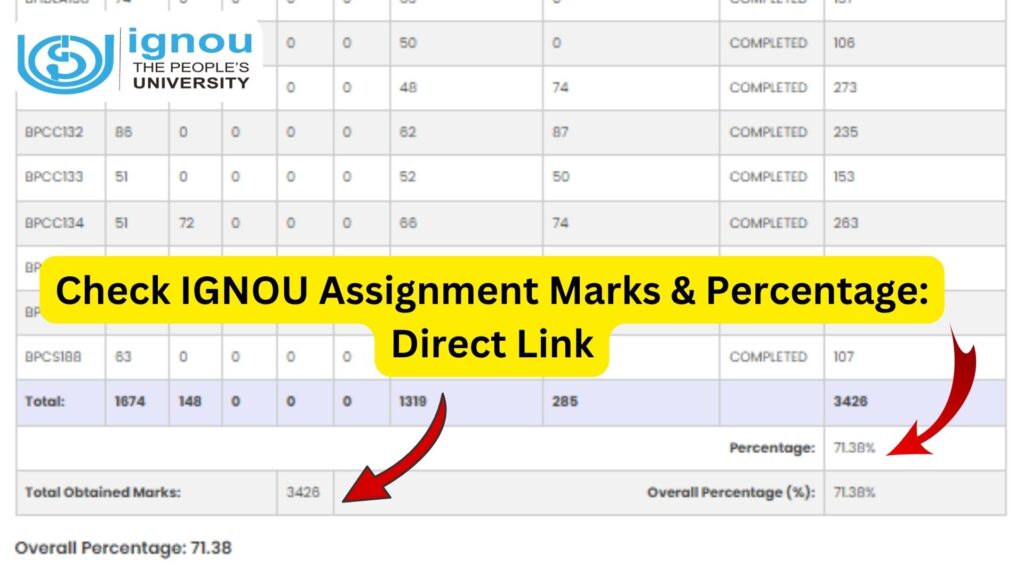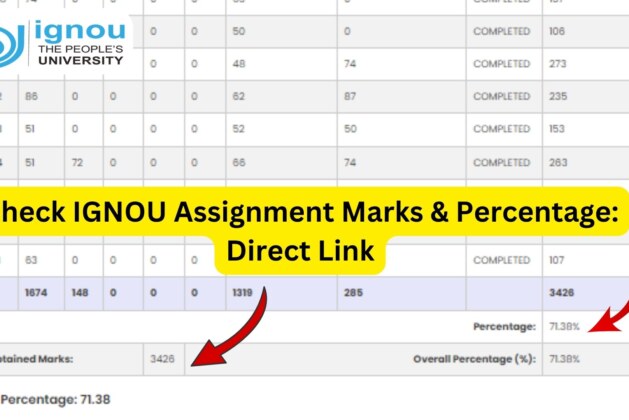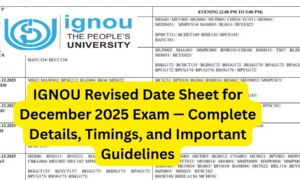IGNOU Assignment Marks: Assignments form a vital component of the evaluation system at IGNOU (Indira Gandhi National Open University). For many courses, you cannot appear for the Term-End Examination (TEE) until you submit assignments and get them evaluated.

Your assignment marks contribute a certain percentage of the overall course grade. Understanding how assignment marks work, how to check them, and how to interpret them is key to performing well in your IGNOU programme.
What Are IGNOU Assignments and Their Role?
Assignments in IGNOU are not optional. For nearly all undergraduate, postgraduate, diploma, or certificate programmes, IGNOU requires students to submit assignments (also called “Tutor Marked Assignments” or TMAs) for each course (subject). These assignments are evaluated by the assigned tutor or evaluator, and marks obtained are recorded in the university records.
The main roles of assignment submissions are:
- Continuous Assessment
Assignments serve as a means of ongoing assessment, rather than only relying on the one-time exam. They help instructors (tutors) gauge your understanding throughout your study period. - Eligibility for Term-End Examination
In many courses, submission and evaluation of assignments are mandatory; students who fail to submit assignments (or get them evaluated) may not be permitted to appear in the TEE (Term-End Exam). - Contribution to Final Grade
The marks earned in assignments count toward your final grade/percentage for that course. They are combined with your Term-End Examination marks based on a predetermined scheme. - Feedback and Improvement
Good assignments come with feedback, which helps you identify weak areas and improve before the final exam.
Because of these factors, assignment marks carry significance. A high assignment score can cushion weaker exam performance; a low assignment score can reduce your overall percentage significantly.
Weightage of Assignment Marks
The percentage weight that assignment marks carry differs by programme and by course. Typically:
- In many undergraduate or postgraduate courses, assignments may carry 30% weightage, while the Term-End Examination carries 70%.
- In some courses, the weightage could be 25% assignments and 75% exam, or 20% assignments, etc.
- Some courses may have internal evaluation or project work, and in such cases, the assignment component can vary more.
For instance, in a course where assignment weight is 30%:
- Maximum marks for that course = 100
- Assignment marks = 30
- Examination marks = 70
After you get assignment marks and exam marks, IGNOU merges them to compute your final course score.
Because of this integration, doing well in assignments is critical; ignoring assignments or getting low marks can drag down your overall academic performance.
How Assignment Evaluation Works?
Here is a typical process of how assignment evaluation is managed at IGNOU:
- Receiving Assignment Keys / Questions
Early in your study cycle (often in the first semester), IGNOU releases assignment question papers (with codes) for each course. You download them, write answers following guidelines (word limit, structure), and submit them at your designated study centre or through the online submission if allowed. - Submission and Receipt
You submit the completed assignment by a stipulated deadline, generally a few months before the term-end exam. You may receive an acknowledgement slip or stamped receipt from the study centre. - Allocation to Evaluator
After submission, your assignment is sent to a tutor or evaluator (internal to IGNOU) associated with your study centre or regional centre. - Evaluation / Marking
The evaluator checks your assignment, marks (assigns scores) based on a marking scheme or rubric, and may give feedback or comments. They encode the marks into IGNOU’s system. - Entry into IGNOU System
Once marks are entered into the university’s records, they are accessible (usually) to the student via an online portal or by request through study centre or regional centre. - Adjustment / Re-evaluation (if applicable)
If there is a mistake or you believe evaluation was unfair, IGNOU may permit a re-evaluation or correction on a case-by-case basis (depending on university rules). You may need to apply through the regional centre.
After the evaluation, your assignment marks are combined with your exam score to produce your final grade or percentage for that course.
Checking IGNOU Assignment Marks and Percentage
To see how you performed in assignments (and the percentage), IGNOU provides an online facility or third-party mirror sites to check assignment marks. One such link is:
Check assignment marks and percentage: https://www.ignoubank.com/ignou-assignment-marks/
Using this link you can view your assignment marks and, often, the percentage of marks achieved in assignments for each course.
Steps to Check Assignment Marks
Although there may be slight variation depending on the interface, a typical sequence might be:
- Go to the link: https://www.ignoubank.com/ignou-assignment-marks/
- You will see a form asking for your Enrollment Number, Course Code(s), or other credentials (such as programme code or session).
- Enter your details and submit.
- The portal retrieves your assignment marks from the IGNOU database and displays them on screen.
- The display may show assignment marks course-wise, total marks out of total possible, and percentage.
- You may have the option to download or print the assignment marks statement.
Because this is not the main official IGNOU portal (but a mirror / aggregator), results may depend on synchronization of data. If your marks are not visible, you should contact your regional centre or study centre.
While this third-party link is useful, always cross-check with the official IGNOU system (if such a facility is available on IGNOU’s own site or student portal).
Interpretation: Assignment Marks Versus Percentage
When you check your assignment marks, the portal or system may show:
- The raw marks obtained (for each course)
- The maximum marks for assignment for that course
- The percentage (i.e. (marks obtained / maximum assignment marks) × 100)
For example, if your assignment carries 30 marks and you get 24/30:
- Raw score = 24
- Percentage = (24 ÷ 30) × 100 = 80%
That is a good assignment score.
Then, when combined with the term-end exam, your overall performance will depend on the weightage formula. For instance, if the exam weight is 70 marks and you score 50/70, your total might be converted to the common denominator (e.g., 100).
Thus, a strong assignment score can improve your overall percentage, especially if your exam score is moderate.
Importance of Assignment Marks
Let’s elaborate on why assignment marks hold significance:
- Academic Safety Net
If your exam is difficult or you lose marks, a strong assignment score helps protect your overall grade. - Minimum Requirement for Eligibility
Some programmes require a minimum assignment percentage to even permit exam appearance. If assignments are missing or poorly scored, you might be barred from exam. - Better Final Grades
Because assignment marks are part of the final calculation, higher assignment performance leads to higher overall percentage and better grades (e.g., First Division, Distinction). - Skill Development
Assignments test your comprehension, research ability, and writing skills. Good feedback helps you improve in future coursework and examinations. - Record and Backup
If your exam result is challenged or re-checked, having a good assignment record supports your case.
Because of all these reasons, assignments should not be treated casually — treat them seriously and put in genuine effort.
Common Problems / Issues and Their Solutions
Even though the system is structured, students may face issues relating to assignment marks. Some common problems include:
| Problem | Cause | Solution |
|---|---|---|
| Marks not visible on portal | Marks not yet entered or synced | Wait for some days; contact study centre / regional centre |
| Marks are incorrect | Error by evaluator or data entry mistake | Apply for rechecking or correction via regional centre |
| Assignment marked zero or very low | Late submission, missing pages, poor content | Submit complete assignment next cycle; review guidelines and improve |
| Portal shows “No record found” | Wrong enrollment/course code or not eligible | Verify details and try again; check with centre |
| Delay in evaluation | High load or backlog at centre or assessor | Be patient; follow up with your centre |
| Missing feedback | Evaluator did not write comments | Request feedback from tutor / study centre |
If any discrepancy persists, escalate to your Regional Centre / Student Evaluation Division (SED) with proof (copy of your submitted assignment, acknowledgement slip, and enrolment details).
Tips to Score Better in IGNOU Assignments
To maximize your assignment marks, consider the following best practices:
- Understand the Assignment Questions Carefully
Read the assignment instructions and all questions fully. Understand the theme, sub-parts, and keywords. - Stick to Word Limits and Format
IGNOU assignment questions often specify word limits (e.g., 500 words, 1000 words). Adhere strictly. Include headings, subheadings, numbering, references. - Use Proper Structure
Use introduction, body, conclusion format. Use bullet points, examples, and case studies where relevant. - Refer to Study Material and Readings
Base your answers on the official study blocks, reference materials, and suggested readings. Avoid random content. - Clarity and Presentation
Write clearly and legibly (if handwritten). If typed, ensure formatting is clean and readable. Use good language, grammar, and coherence. - Time Management
Don’t wait until the last minute. Allocate time for drafting, revising, proofreading, and checking completeness. - Include References / Citations
If relevant, cite sources or readings. It shows seriousness and depth in response. - Submission in Time
Late submissions may be penalized or rejected. Always submit before the deadline and get acknowledgement slip. - Get Feedback and Learn
Review the feedback from your evaluator. Note recurring mistakes and avoid them in future assignments. - Multiple Drafts / Revising
First write a draft, revise and polish, then finalize the answer before submission.
By combining content knowledge with disciplined writing and planning, you can improve your assignment marks substantially.
Important Links & Information
Below is a table summarizing key links and relevant information regarding IGNOU assignment marks:
| Purpose / Information | Link / Detail |
|---|---|
| Check IGNOU Assignment Marks & Percentage | https://www.ignoubank.com/ignou-assignment-marks/ |
| IGNOU Official Website | https://www.ignou.ac.in/ |
| Student Support / Evaluation Division (SED) | (Contact via IGNOU regional centre) |
| Assignment Submission Requirement | Mandatory for most courses to be eligible for exam |
| Assignment Weightage | Varies by course (commonly 25%–30%) |
| Re-evaluation / Correction | Request through regional centre / SED |
| Assignment Feedback | Provided by evaluator with comments |
| Record-keeping Advice | Keep submission receipts, assignment copies |
| Delay Issues | Follow up with study centre / regional centre |
FAQ about IGNOU Assignment Marks
How are IGNOU assignment marks calculated?
Assignment marks are awarded by the evaluator based on your submitted work. The marks you receive are out of the maximum assignment weight (e.g., 30 marks). The portal may also show the percentage (i.e., marks obtained divided by maximum). These marks are then combined with your exam marks to compute the final course grade.
Where can I check my IGNOU assignment marks?
You can check your assignment marks and percentage via the following link:
https://www.ignoubank.com/ignou-assignment-marks/
You need to enter your enrollment number, course code, and possibly other details to view your marks.
What if my assignment marks are not showing on the portal?
If your marks are not visible, possible reasons include:
The evaluator has not yet entered them
The data sync between IGNOU system and portal is delayed
You used incorrect enrollment or course code
Your assignment was not accepted or recognized
In such cases, wait a few days, recheck your details, or contact your regional centre / study centre for assistance.
Can I request re-evaluation of my assignment?
Yes, under certain conditions IGNOU allows re-evaluation or review of assignment evaluation. You will have to approach the Regional Centre or the Student Evaluation Division (SED), submitting a formal request (sometimes paid) along with justification.
Do assignment marks matter for passing the course?
Yes, assignment marks contribute to your final course grade. If your assignment component is poor, even a good exam score may not lead to a high overall grade. In some programmes, submission of assignments is mandatory to be eligible for appearing in the exam.
Will I get feedback on assignments?
Generally, evaluators provide brief comments or remarks along with the marks: pointing out strengths and weaknesses. This feedback is useful to improve in future assignments or the term-end exam.
How long does it take for assignments to be evaluated?
The timeline varies depending on workload at study centre / regional centre and evaluator availability. Usually you might see marks within few weeks to a couple of months of submission.
What if I submitted my assignment late?
Late submissions may be accepted only if IGNOU or your study centre allows extension, or they may attract penalties (marks deduction) or rejection. Always adhere to deadlines.
Will missing an assignment disqualify me from the exam?
In many courses, yes. Without assignment submission and evaluation, you may not be allowed to sit for the term-end exam. The assignment component is mandatory in such cases.
Can assignment marks be higher than exam marks in importance?
No, exam marks usually carry heavier weightage (e.g. 70%) than assignments (e.g. 30%). However, assignment performance is still critically important as it forms part of the final grading.
Can I combine assignment marks of multiple courses?
No, assignment marks are specific to each course. You cannot mix or transfer marks across different courses.
Will IGNOU notify me when assignment marks are available?
Sometimes, your study centre or IGNOU’s regional centre may announce that assignment results have been published. But you should proactively check the portal or contact your centre.
After how many days should I expect assignment marks to reflect?
Often within a few weeks to two months after submission. However delays may occur depending on evaluation backlog.
What if evaluator marked wrong subject or wrong course code?
In such a case, you should approach your regional centre with proof (your assignment copy, acknowledgment, enrollment records). IGNOU may correct the mistake.
Should I keep a copy of my submitted assignment?
Yes, always retain a copy (photocopy or scanned version) of your submitted assignment and the submission receipt / acknowledgement slip. This helps in case of disputes.
Conclusion
IGNOU assignments are a core pillar of the continuous evaluation process. Assignment marks not only contribute directly to your final grade but also act as a safety buffer and learning tool. Checking your assignment marks (via links such as https://www.ignoubank.com/ignou-assignment-marks/) allows you to monitor your performance and take corrective steps if needed.
To excel in assignments, begin early, carefully follow instructions, write structured answers, submit on time, and always retain proof of submission. If any issues arise—such as missing marks or errors in evaluation—address them promptly through your study centre or regional centre. With consistent effort and attention to assignments, you give yourself a stronger base to succeed in your IGNOU examinations and academic journey.




Leave a comment